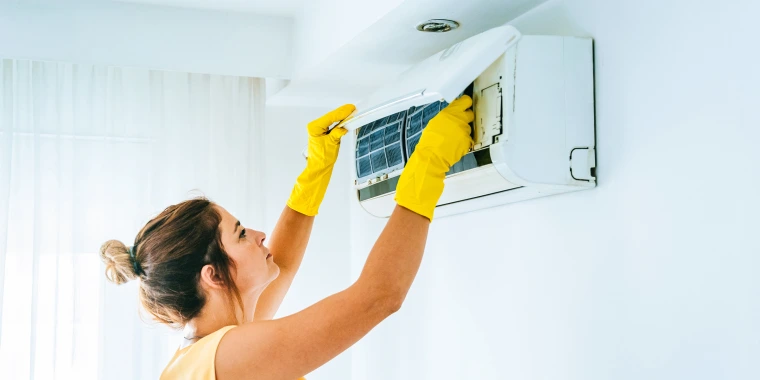Ensuring the optimal performance of your air conditioning (AC) system is paramount for creating a comfortable and healthy indoor environment. One crucial aspect of AC maintenance is regularly cleaning the AC filter. A clean filter not only enhances the efficiency of your AC unit but also plays a pivotal role in improving indoor air quality. In this comprehensive guide, we will focus on the importance of a clean AC filter, highlight the signs that indicate the need for cleaning, and provide you with detailed, step-by-step instructions on how to clean AC filter effectively.
Importance of Maintaining Clean AC Filters
Ensuring the optimal performance of your air conditioning (AC) system is paramount for a comfortable and healthy indoor environment. The air filter in your AC system plays a vital role in trapping dust, debris, pollen, and other airborne particles. Over time, however, the filter can become clogged, hindering airflow and forcing the AC unit to work harder. This not only reduces the system’s efficiency but also leads to increased energy consumption and higher utility bills.
Additionally, a dirty AC filter can compromise indoor air quality, posing potential health risks. As the filter becomes saturated with contaminants, it can no longer effectively capture new particles, allowing them to circulate throughout your home. For individuals with pre-existing conditions such as respiratory issues or allergies, this can exacerbate symptoms and contribute to overall health concerns.
Recognizing the signs of a dirty filter is crucial for timely intervention. Reduced airflow, increased energy bills, uneven cooling, strange odors, or visible dirt on the filter are indicators that cleaning is necessary. Ignoring these signs not only affects your AC system’s efficiency but also poses health risks due to poor indoor air quality.
To address this, regular cleaning of your AC filter is essential. By following a simple step-by-step guide, you can maintain a clean and efficient air conditioning system, ensuring optimal performance and a healthier indoor environment. Make AC filter maintenance a routine part of your home care to enjoy the benefits of a well-maintained and efficient air conditioning system while safeguarding your indoor air quality and overall well-being.
Signs Your Air Conditioner Filter Requires Clean-up
Reduced Airflow:
If you notice decreased airflow coming through your vents, this could be an indicator that your AC filter has become clogged up, placing added strain on the system and decreasing efficiency. Restricting airflow puts additional stress on the system leading to reduced efficiency overall.
Increased Energy Bills:
When an AC unit must work harder to keep temperatures within its set range, energy consumption and utility bills go up accordingly. Regularly replacing or cleaning its filters can help decrease these expenses and save on energy consumption costs.
Uneven Cooling:
Rooms not cooling as effectively may be due to a clogged filter, as proper airflow is essential for temperature distribution across your home.
Strange Odors:
Over time, a dirty filter may accumulate particles that produce musty or unpleasant smells when your AC runs, which should prompt you to inspect and clean its filters regularly. If strange odors start emanating from your system when running AC, now may be an ideal time for the maintenance of these filters.
Visible Filter Dirt:
One telltale sign that an AC filter needs attention is visible dirt and debris on its surface. If there’s dust or grime visible, then it’s time to either clean or replace the filter.
How to Clean Air Conditioner Filter Easily
Cleaning an AC filter is a straightforward task that takes minimal time and tools. Here is our step-by-step guide on how to do so for optimal air conditioning performance:
Step 1: Switch Off The Air Conditioning Unit (AC)
Before beginning to clean the filter, be sure to turn off the AC unit. This will prevent additional dust from being drawn into your system while working on it.
Step 2: Locate the AC Filter
Filters for air conditioner systems are typically located either within the return air duct or near its indoor unit, depending on your AC model. If in doubt about its exact location, refer to your AC’s manual.
Step 3: Carefully Extract the Filter
To safely and carefully extract your filter from its housing, be careful when unplugging or sliding out. Most filters are designed for this process and will typically come out without needing tools.
Step 4: Examine Filters
Examine the filter closely for visible dirt, dust and debris. Place it under bright lighting to detect any blockages or clogs; if a disposable filter has reached its end of lifecycle and should be replaced with a new one.
Step 5: Clean Your Filter
If your filter is reusable, you can clean it using one of these methods:
- Vacuuming: Use a vacuum cleaner equipped with a nozzle attachment to carefully and thoroughly vacuum both sides of the filter to remove surface dust and debris from its filter surface. Be sure to cover both surfaces when vacuuming both filters simultaneously.
- Rinsing with Water: For stubborn dirt, rinse the filter with water using a gentle stream of water from one side of the filter to another; start from the clean side and direct towards the dirty side for maximum effectiveness. Let it air dry completely before reinserting it.
- Soaking with Mild Detergent: For filters that have become particularly dirty, soak them in a solution of mild detergent and water for 15-20 minutes before gently brushing away any remaining dirt with a soft-bristled brush and then rinsing thoroughly and allowing them to dry before reinstalling them.
Step 6: Reinstall Filter
Once your filter is clean and completely dry, reassemble it with its housing making sure it fits tightly and according to any arrows or markings on its filter that indicate airflow direction.
Step 7: Switch On The AC Unit
Once the clean filter has been installed, restart the air conditioner. Carefully observe it to make sure airflow has returned and that its operation remains efficient.
How Often Should You Clean Your Air Conditioner Filter?
Cleaning your AC filter depends on several factors, such as:
- Type of Filter: Different kinds of filters come with differing lifespans and maintenance needs; always consult the manufacturer’s recommendations when purchasing or cleaning any filter type.
- Usage: If your AC system is used regularly during peak seasons, such as May and June, its filter should be checked every 1-3 months for cleaning purposes.
- Indoor Air Quality: If you live in an area with high levels of dust, pollen, or other airborne particles, cleaning the filter more regularly may be necessary to keep air quality healthy.
- Pets: Pet dander and fur can contribute to an accumulation of debris on your filter more quickly, so consider inspecting and cleaning it more often in households with pets.
Final Words:
Regularly cleaning your AC filter is a straightforward yet impactful practice that significantly contributes to the optimal performance of your air conditioning (AC) system. This simple maintenance task ensures not only enhanced energy efficiency but also an improvement in indoor air quality.
By attentively recognizing the signs of a dirty filter, such as reduced airflow, increased energy bills, uneven cooling, strange odors, or visible dirt on the filter, you can promptly address the issue. Following the step-by-step cleaning guide provided earlier allows you to efficiently clean and maintain your AC filter, ensuring it functions at its best.
This proactive approach to AC filter maintenance goes beyond just immediate benefits. Regular cleaning contributes to extending the overall lifespan of your AC system. A clean filter facilitates better airflow, reducing the strain on the unit and minimizing wear and tear on crucial components. As a result, you can expect a longer and more reliable service life from your AC system.
Moreover, the impact on indoor air quality is noteworthy. A clean filter effectively captures and removes dust, debris, and other airborne particles, preventing them from circulating throughout your home. This is particularly crucial for individuals with respiratory conditions or allergies, as a well-maintained AC system contributes to a healthier living space.
To fully reap the benefits of a well-maintained and efficient air conditioning system, integrate AC filter maintenance into your regular home care routine. Consider setting reminders to check and clean the filter every 1-3 months, or as recommended by the manufacturer.
Elevate your comfort with expert AC care. Click here for reliable AC repair in Dubai and trust our services for more on enhancing your cooling experience.

